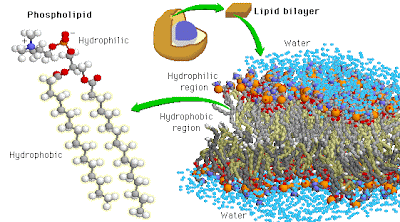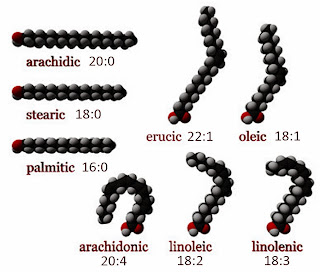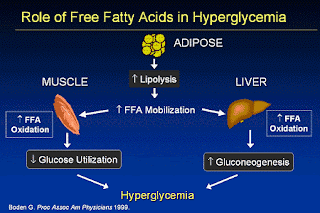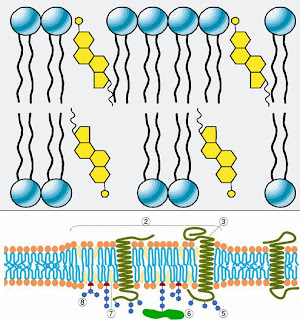Biology concepts – lipid, phospholipid, eicosanoid, sterol, unsaturation, omega fatty acids, essential fatty acids, fluid mosaic model, lipid droplets, myelination
Beydoun MA, Fanelli Kuczmarski MT, Beydoun HA, Hibbeln JR, Evans MK, & Zonderman AB (2013). ω-3 Fatty Acid Intakes Are Inversely Related to Elevated Depressive Symptoms among United States Women. The Journal of nutrition, 143 (11), 1743-52 PMID: 24005610
Li Z, Thiel K, Thul PJ, Beller M, Kühnlein RP, & Welte MA (2012). Lipid droplets control the maternal histone supply of Drosophila embryos. Current biology : CB, 22 (22), 2104-13 PMID: 23084995
Vlaeminck B, Dufour C, van Vuuren AM, Cabrita AR, Dewhurst RJ, Demeyer D, & Fievez V (2005). Use of odd and branched-chain fatty acids in rumen contents and milk as a potential microbial marker. Journal of dairy science, 88 (3), 1031-42 PMID: 15738238
Last week we talked about fat, but fats are just one of the many lipids in living organisms. Lipids are the fourth of our four biomolecules; we’ve already discussed proteins, carbohydrates and nucleic acids. Lipids may be last, but they're certainly not least.
Basically, all fats are lipids, but not all lipids are fats. The players are varied both in structure and function. Fats are three fatty acids + glycerol, but lipids are any of a group of organic compounds, including fats, oils, waxes, sterols, and triglycerides. The unbroken rule is that all lipids are insoluble in water, soluble in nonpolar organic solvents, and oily to the touch.
All lipids are made from fatty acids – although only about half are recognizable as fatty acid products. Fats are a glycerol molecule with three fatty acids attached, but phospholipidsare usually a glycerol with just two fatty acid chains. The third glycerol position is taken by the head molecule of the phospholipid. The common heads are choline, ethanolamine, and the amino acid serine. Yet another non-protein function of an amino acid.
Phospholipids spontaneously form lipid bilayers (see picture) and spherical hollow spheres, which are perfect for making cell membranes. The heads are hydrophilic (hydro = water, and philia = loving) while the fatty acid tails are hydrophobic (phobia = fear). This makes for a potent cell membrane, keeping the large water-soluble molecules inside the cell because they won’t pass through the hydrophobic tail region. Notice how the two hydrophilic regions face water, while the two hydrophic portions of each layer hide on the inside.
The cell membrane isn’t made of only lipids; there are thousands of different proteins that perform many functions – signaling, receiving chemical messages, acting as channels and transporters for different molecules that can’t make it through the membrane on their own. There are also some other lipids in the membrane that we will talk about in a minute.
Sphingolipids also sit in membranes, but they are usually asymmetric. This means that there are usually more of these in the outer layer of the phospholipid bilayer, also called the outer leaflet. From here they participate in a lot of the signaling through the membrane and in protecting the membrane from damage. When the cell is damaged and needs to commit suicide (apoptosis), divide, reduce its function (senescence), or differentiate (change what type of cell it is), part of the signaling will go through the sphingolipids.
The fatty acids that make of the hydrophobic tails of phospholipids and sphingolipids can vary; even the two fatty acids on a single phospholipid can be different. One of the most common phospholipids is DPPC – dipalmitoylphosphatidylcholine. This means the head molecule is phosphocholine, the backbone is glycerol, and the two fatty acids are both palmitic acid, a fatty acid with no double bonds (saturated) and a chain of 16 carbons.
Palmitic acid itself is designated as C16:0, meaning it has 16 carbons and zero double bonds; oleic acid is C18:1, and so on. Fatty acids of two to 36 carbons have been found in nature, with many variations as to the number of double bonds.
But there are exceptions. Ruminant animals have about 5% odd chain fatty acids, much more than other mammals. Why would this be?
What if I told you that bacteria and plants have lots of odd chain fatty acids? Ruminants (cows and such) have lots of bacteria in their numerous stomachs; the microbes help break down the plant cellulose of the ruminants’ plant diet. Naturally, some of these odd number FAs get incorporated into the animals’ tissues. A 2012 review pieced together the evidence so that changing levels of odd chain fatty acids in the stomachs of cows could be used to predict rumen health. More of C17:0 for instance, might indicate a rumen acidosis.
Free fatty acids (FFA) are attached to nothing, and rarely found on their own. In fact, they can be toxic in high concentrations. However, when we break down triglycerides to burn for energy, the fatty acids are released as FFA, so a low level can be found in the blood. Does that mean it's bad to lose weight too quickly; could you release so much FFA that you toxify yourself? Exercise might be dangerous!
Here comes an exception - heart and skeletal muscle actually preferto use FFAs as energy sources as compared to glucose! This may be due to the higher energy storage potential of fatty acids, these high energy demanding tissues can get more bang for their buck by using fatty acids. The difference is that these fatty acids are usually bound to albumin in the blood, so they are not toxic like free fatty acids.
We humans can make most of the fatty acids they need. But, as with amino acids, there are a couple that we must get from our diet. These are the essential fatty acids, linolenic (C18:3n-3) and linoleic (C18:2n-6). The terminology is getting deep, but these are the omega three and omega 6 fatty acids. We can’t make double bonds beyond the #9-10 carbons in a fatty acid chain, so the omega fatty acids have to be brought on board by eating fish and plant oils (see the picture above).
Another 2013 study showed that the number of self-reported depressive symptoms in American women are inversely proportional to the amount of omega-3 fatty acids consumed in their diet. Eat fish to be happy!
The essential fatty acids + arachidonic acid (20:4n-6) are also important for constructing another form of lipid – the eicosanoids(including the prostaglandins, thromboxanes and prostacyclins and leukotrienes). However, eicosanoids are so modified that it would be hard to tell they were based on fatty acids. These lipids are essential for the function of the immune system, including controlling inflammation, clotting, pain, and fever.
The exception to this is the endocannabinoids. These molecules do work in inflammation, but also have a lot to do with regulating mood and behavior. This may be why essential fatty acids are important in treating depression. You have probably noticed that the word (and structure) of the endocannabinoid bears resemblance to the active ingredient in marijuana – tetrahydrocannabinol (THC). This may also reflect their mood altering capabilities.
The final group of lipids we will talk about are the sterols. These (and the cardiolipins) are based on ring structures (see picture), having started out as fatty acids. The functions of sterols are many and diverse. They serve in hundreds of different signaling systems as a major class of hormones (like the sex hormones testosterone and estradiol and the metabolic hormone cortisol).
So those are the lipids - definitely necessary for long-term energy storage, but also crucial for cell integrity and nearly every other function in an organism. Just to highlight this, let’s look at two very different functions of lipids.
Your brain just don’t work good without lipids! Many of your neurons have a lipid coating around them called myelin. The electrical impulse travels down the neuron in an unmyelinated neuron (grey matter), but can jump from the gap to gap (called nodes) in a myelinated neuron (white matter). This makes for much faster processing of neural signals, and is the only reason we can function at the level we do.
Trouble with lipid storage and function (called lysosomal lipid storage diseases) will mess with myelination. Diseases like Gaucher’s disease and Niemann-Pick both have myelination problems, and can result in severe mental retardation. These are inherited diseases, but there is an exception. Poisoning with swainsonine (from a plant called locoweed) can also result in poor lipid storage and function. It can drive cows mad (get it - locoweed), but is also a promising cancer drug.
Lastly, lipids control your genes. Lipid droplets in your cells interact with the histone proteinsthat control the packaging of the DNA. DNA wrapped around histones tightly is not open to be replicated or transcribed, so no genes there can be made into protein. But a 2012 study in fruit flies showed that lipid droplets are intimately associated with proper development. Lipid droplets serve as a reservoir of histones, which can be toxic when floating freely. If lipid droplets decrease, excess histones are free to wreak havoc, and the embryo dies. Still think fats are to be avoided?
Next week, let get into the holiday spirit by looking at the biology of snow. It saved Rudolph from being a meal for some predator!
For more information or classroom activities, see:
Essential fatty acids –
Phospholipids –
Sterols –
Lysosomal lipid storage diseases –
Fluid mosaic model -






